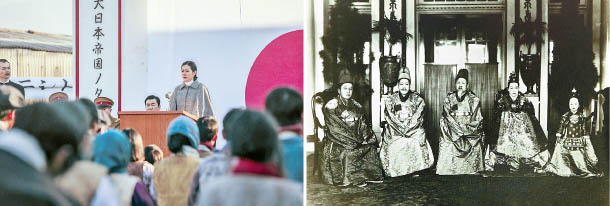[FICTION VS. HISTORY] ‘The Last Princess’ underplays a real royal tragedy: The basics are all there, but the movie’s patriotic heroism ignores the truth of an empty, lonely life

From left: A scene in the period film “The Last Princess” (2016), depicting the life of Princess Deokhye (played by Son Ye-jin); a real photograph of the royal family, featuring Emperor Gojong, center, and Princess Deokhye, right. [LOTTE ENTERTAINMENT, JOONGANG ILBO]
But in 2016, the period film “The Last Princess” hit theaters and rekindled vague memories of the princess. Directed by Hur Jin-ho, “The Last Princess” is based on the true, tragic story of Princess Deokhye (played by actor Son Ye-jin).
In the film, Deokhye is portrayed as this strong, empowered woman who continues to show resistance to Japan’s annexation of Korea. In the film, after witnessing the poor children of Korean laborers in Japan, Deokhye establishes a Korean language school to educate the kids. She also makes a heart-wrenching speech in front of the Joseon laborers who were forced to work in Japan, costing her the opportunity to see her dying mother in Korea. She encourages them to hold on to hope - the hope of independence. Moved by her speech, the laborers begin to sing “Arirang.”
That depiction of Princess Deokhye infuriated some patriotic audiences as the real Princess Deokhye was actually known as an insecure, introverted woman. There’s no document of any kind that suggests she was involved in any patriotic activity.
Then what part of the movie version of the princess is true?
The director says at the beginning of the movie that it is a “sheer creation based on true stories.” The film is, in fact, based on the novel “Princess Deokhye” by Kwon Bi-young. The major incidents in her life stay fairly true to history. Despite her young age, Emperor Gojong tries to betroth the little princess with a young boy called Kim Jang-han, nephew of Kim Hwang-jin, a court chamberlain, to protect Princess Deokhye from Japan. However, Emperor Gojong is poisoned and the film shows how Deokhye is forced to live in Japan under strict surveillance from the age of 14.
She was forced to marry a Japanese count named Takeyuki So. The film shows how her daughter killed herself and the princess was locked up in a mental hospital in Japan until she was permitted to come back to Korea. She attempted to return home after Korea gained sovereignty, but the Syngman Rhee government did not grant permission for the royal family to return, fearing political fallout.

From left: A wedding photograph of Princess Deokhye and Japanese Count Takeyuki So; Nakseonjae Hall in Changdeok Palace, central Seoul, where Princess Deokhye lived until her death after returning to Korea; and the princess’ last handwritten document that says she wants to live in Nakseonjae Hall forever. [JOONGANG ILBO]
All these major events are accurately portrayed in the film, but the details have been fictionalized to maximize the drama.
For example, historical documents state that a newspaper reporter named Kim Eul-han tracked down Princess Deokhye in Japan and helped her return to Korea. In the film, however, Jang-han (played by Park Hae-il), the man whom Emperor Gojong had initially wanted to marry his daughter, is the one who finally discovers her after many years and brings her back home. There’s no historical records that suggests he was really involved in the independence movement, as depicted in the film.
The villain in the film is a pro-Japanese man named Han Taek-su, played by actor Yoon Je-moon. He is the man who forces the princess to live in Japan, arranges her marriage with a Japanese count and interferes with the princess returning to Korea. This character and his misdeeds are all based on facts, except his name, which in real life was Han Chang-su.
The film also dramatically depicts the mission of the Koreans to help King Yeongchin, the seventh son of Gojong and the last crown prince of Joseon, together with his wife and Princess Deokhye. The mission ends in failure with the sacrifice of many Korean independence fighters. However, historical records merely show there were plans to have King Yeongchin take refuge in China, but they were never put into action.
“When I watched ‘The Last Princess,’ my eyes were reddened, but at the same time, I kind of felt this emptiness at the end of the film because it’s very far from the real history,” wrote Choi Joong-kyung, the president of the Korea Institute of Certified Public Accountants in his column at The Korea Economic Daily on Jan. 14. “I can remember how disappointed I was in history class to learn how incompetent the Joseon rulers were. It was wrong for Japan to forcefully invade Korea, but we should not try to view this historical incident as ‘evil Japan infringing upon the good Korean people.’”
Choi also said that it is “understandable that period films need to add drama, but distorting history for entertainment’s sake is not acceptable.”
BY YIM SEUNG-HYE [sharon@joongang.co.kr]










with the Korea JoongAng Daily
To write comments, please log in to one of the accounts.
Standards Board Policy (0/250자)